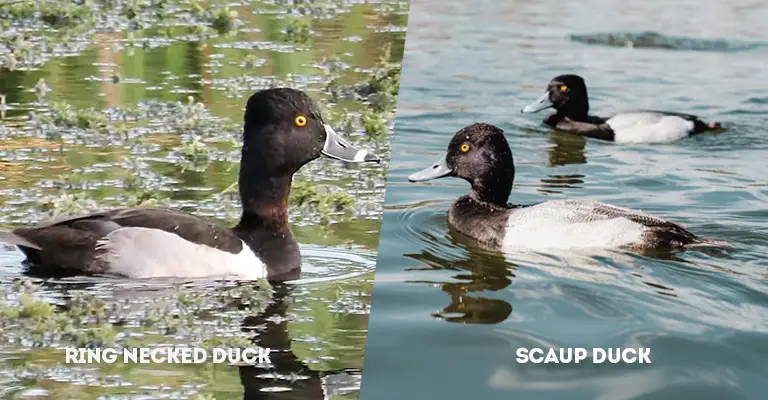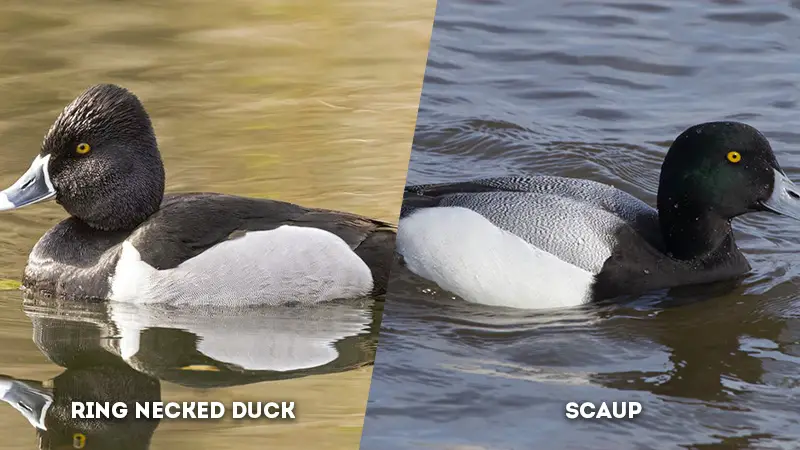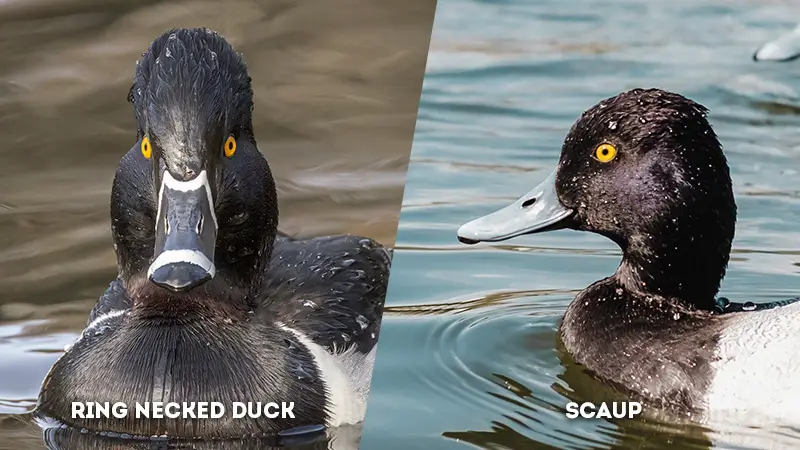Diving ducks, a fascinating group within the avian world, encompass an array of species each uniquely adapted to aquatic habitats.
Among them, Ring-necked Ducks and scaups stand out as distinct members, exhibiting remarkable differences in their characteristics, behaviors, and ecological roles.
From their preferred habitats to vocalizations, bill shapes, and conservation statuses, these ducks offer insights into the intricacies of avian adaptation.
Delving into their features unveils the intricate balance between form and function, reflecting how these species have evolved to thrive in diverse environments.
This exploration highlights their vital roles in ecosystems and invites a deeper appreciation for the diversity of life within the avian realm.

Key Differences Between Ring-necked Ducks and Scaups
Here are some of the main differences between ring-necked ducks and scaups:
Distribution
- Ring-necked Duck: Ring-necked Ducks are found across North America and northern Eurasia. They migrate to southern US and Mexico for winter, preferring shallow wetlands with emergent vegetation like wild celery. They also nest in boreal forest ponds and marshes.
- Scaup: Scaups inhabit the Palearctic and Nearctic regions. Two species, Greater and Lesser Scaup, exist. They frequent freshwater lakes, rivers, and marshes during breeding. Wintering areas vary with species and region, showcasing their adaptability to diverse environments.
Habitat Preference
- Ring-necked Duck: Ring-necked Ducks display a distinct habitat preference for shallow wetlands adorned with a fringe of emergent, submerged, or floating vegetation. These wetlands often host plants like wild celery, bulrush, pondweed, and pond lily.
This choice of habitat provides them with both food and shelter. They particularly favor areas with these features, making them well-suited for nesting and foraging. - Scaup: Scaups, on the other hand, exhibit a different habitat preference. They tend to inhabit a broader range of freshwater environments such as lakes, rivers, and marshes during their breeding season.
Unlike the Ring-necked Ducks’ emphasis on wetlands with specific vegetation, scaups are more adaptable to open waters. This preference allows them to explore a wider variety of aquatic habitats and exploit diverse food sources.
Head Color (Males)

- Ring-necked Duck: Male Ring-necked Ducks are recognizable by their dark heads, but what sets them apart is a subtle chestnut-colored ring around their neck, from which their name derives.
This distinctive feature, although not always immediately noticeable, provides an intriguing touch to their appearance, helping differentiate them from other duck species. - Scaup: Male scaups present an intriguing contrast in head coloration. The Greater Scaup displays a rich black head, providing a bold and striking appearance. In contrast, the Lesser Scaup exhibits a purplish head with a white crescent near the base of its bill.
This variation in head coloration adds uniqueness to the two scaup species, allowing birdwatchers and enthusiasts to distinguish between them.
Body Color (Males)

- Ring-necked Duck: The male Ring-necked Duck’s body is predominantly gray, creating a subdued yet handsome appearance. This muted color scheme serves as a suitable camouflage in their wetland habitats, allowing them to blend into their surroundings.
- Scaup: Both species of scaups boast distinct body coloration. The Greater Scaup features a white body, which starkly contrasts with its black head. In contrast, the Lesser Scaup showcases a purplish sheen on its body.
These variations contribute to the overall aesthetic diversity among diving ducks, reflecting their adaptation to different environments.
Neck Iridescence
- Ring-necked Duck: Ring-necked Ducks do not prominently exhibit neck iridescence. Instead, their visual appeal lies more in their subtle neck-ring and their overall understated elegance.
- Scaup: Scaups, particularly the Greater Scaup, stand out with iridescent neck feathers. In the case of the Greater Scaup, the neck exhibits a distinct greenish iridescence, contributing to the male’s eye-catching appearance. This iridescence serves as an attractive display during courtship and adds vibrancy to their visual identity.
Eye-ring (Females)

- Ring-necked Duck: Female Ring-necked Ducks possess a distinctive white eye ring, a feature that aids in identification.
This white circle around the eye provides a subtle but significant contrast to their overall brown plumage, allowing observers to differentiate them from other female duck species. - Scaup: In contrast, female scaups lack the prominent white eye ring seen in Ring-necked Ducks. This absence of an eye ring contributes to their more uniform appearance, which can make their identification slightly more challenging compared to the more recognizable Ring-necked Duck females.
Wintering Areas
- Ring-necked Duck: Ring-necked Ducks undertake seasonal migrations to escape harsh conditions. During the colder months, they migrate to various wintering areas, including the southern United States and Mexico.
This strategic movement helps them access milder climates and abundant food sources, ensuring their survival through the winter. - Scaup: The wintering areas of scaups are diverse and depend on factors such as species and geographic location.
Greater Scaups and Lesser Scaups may exhibit differing wintering patterns. This adaptability to a range of regions reflects the broader distribution and habitat flexibility of the scaup species as a whole.
Primary Feeding
- Ring-necked Duck: Ring-necked Ducks primarily feed on a diet that includes aquatic plants, seeds, and insects. Their preference for shallow wetlands with vegetation provides them with an ample supply of these food sources.
This feeding behavior aligns with their habitat choice, as they can easily access the vegetation in their preferred environments. - Scaup: Scaups are known for their diet of aquatic invertebrates and mollusks, in addition to consuming aquatic plants. This diverse dietary preference enables them to exploit various food sources in their freshwater habitats.
Their ability to feed on both plant matter and aquatic organisms highlights their adaptability to different ecosystems.
Diving Behavior
- Ring-necked Duck: Ring-necked Ducks are characterized as shallow divers. They often feed by diving into the water to access aquatic vegetation and insect prey. Their preference for shallow waters aligns with their habitat choice, which is rich in emergent and submerged vegetation.
- Scaup: Scaups are adept at diving underwater to obtain their food. This diving behavior allows them to explore deeper water bodies in search of aquatic invertebrates and mollusks.
Their ability to dive to greater depths sets them apart from the shallower diving behavior of Ring-necked Ducks.
Breeding Habitat
- Ring-necked Duck: Ring-necked Ducks opt for nesting in boreal forest ponds and marshes. These secluded, freshwater habitats provide the ideal environment for them to build nests and raise their young.
The combination of water and vegetation supports their nesting and foraging needs during the breeding season. - Scaup: Scaups, including both Greater and Lesser Scaups, prefer breeding habitats in open freshwater areas. They choose locations such as lakes, rivers, and marshes for nesting.
This choice reflects their adaptation to different aquatic environments and their ability to adapt their breeding strategies based on available resources.
Distinctive Features
- Ring-necked Duck: The distinctive feature of male Ring-necked Ducks is the subtle chestnut-colored ring around their necks, giving them their name. This unique neck ring is an identifying characteristic that sets them apart from other duck species.
Additionally, their preference for wetlands with emergent vegetation contributes to their distinctive habitat choice. - Scaup: Male scaups stand out with their bold head coloration. The Greater Scaup displays a black head, while the Lesser Scaup exhibits a purplish head with a distinctive white crescent near the base of their bill. This variation in head color serves as a key feature for distinguishing between the two scaup species.
Migration Behavior
- Ring-necked Duck: Ring-necked Ducks exhibit migratory behavior, traveling to wintering areas in the southern United States and Mexico.
This seasonal movement ensures they can access food sources and avoid the harsh conditions of colder regions during the winter months. - Scaup: Scaups are also migratory birds, but their wintering patterns can vary depending on the species and geographic location. Greater and Lesser Scaups may have differing migration behaviors and routes, reflecting their adaptability to different environments.
Bill Color (Males)
- Ring-necked Duck: Male Ring-necked Ducks have a pale blue-gray bill, adding a subtle yet distinctive touch to their appearance. This bill coloration contrasts with their dark head and contributes to their overall color pattern.
- Scaup: Male scaups exhibit intriguing variations in bill color. The Greater Scaup has a blue-gray bill, complementing its striking black head.
In contrast, the Lesser Scaup features a black bill that complements its purplish head color. These bill colorations play a role in distinguishing between the two scaup species.
Bill Shape (Males)
- Ring-necked Duck: The bill shape of male Ring-necked Ducks is characterized by a rounded tip. This bill design suits their feeding behavior, allowing them to access aquatic vegetation and insects in their shallow diving habitats.
- Scaup: Male scaups, including both Greater and Lesser Scaups, have a bill shape with a sloping profile. This bill shape reflects their diving behavior, which involves exploring deeper waters for aquatic invertebrates and mollusks.
Bill Color (Females)
- Ring-necked Duck: Female Ring-necked Ducks exhibit a duller and darker bill color, which complements their overall brown plumage. This subdued bill coloration is consistent with their more understated appearance.
- Scaup: Female scaups, including both species, showcase a grayish bill color. This neutral bill coloration blends well with their plumage, allowing them to camouflage effectively in their freshwater habitats.
Nesting Areas
- Ring-necked Duck: Ring-necked Ducks choose nesting areas in boreal forest ponds and marshes. These freshwater habitats provide the necessary conditions for building nests and raising their young. The combination of water and vegetation supports their nesting needs during the breeding season.
- Scaup: Scaups, both Greater and Lesser species, opt for nesting habitats in open freshwater areas. They select locations such as lakes, rivers, and marshes for their nests. This preference reflects their ability to adapt their nesting strategies based on the available resources and environmental conditions.
Voice
- Ring-necked Duck: The vocalizations of Ring-necked Ducks consist of low growling sounds. These sounds contribute to their communication during courtship and other social interactions. While not as melodious as some other duck species, these vocalizations play a role in their social dynamics.
- Scaup: Scaups produce various vocalizations that range from whistling notes to soft grunts. These sounds serve as means of communication among individuals, helping them coordinate in their flocks and establish their presence in their habitats.
Social Behavior
- Ring-necked Duck: Ring-necked Ducks can exhibit both solitary behaviors and small-group social behavior. They are often seen in pairs or small flocks during migration and wintering. Their social interactions are influenced by their preferred wetland habitats and foraging behaviors.
- Scaup: Scaups, especially during migration and wintering, tend to congregate in larger flocks. Their social behavior involves group activities such as foraging and moving together. This flocking behavior provides them with safety, warmth, and better access to food resources.
Conservation Status
- Ring-necked Duck: The Ring-necked Duck is generally considered of “Least Concern” in terms of conservation status. Their wide distribution and adaptable habitat preferences contribute to their relatively stable population.
- Scaup: The conservation status of scaup species may vary based on the specific species and regions. Some populations of scaups have faced challenges due to habitat loss and other factors.
While the overall status of scaup species may be relatively stable, specific subpopulations might be more at risk.
Hybridization
- Ring-necked Duck: Instances of hybridization involving Ring-necked Ducks are relatively rare. They tend to maintain their distinct species characteristics and behaviors.
- Scaup: Hybridization can occur between different scaup species, particularly where their ranges overlap. Hybrids between Greater and Lesser Scaups have been documented. These hybrids can display intermediate characteristics, making identification challenging.
Distinctive Markings
- Ring-necked Duck: Ring-necked Ducks do not possess distinctive markings in the same way that other species might. Their most recognizable feature is the subtle chestnut neck ring on males.
- Scaup: Scaups, particularly the Lesser Scaup, possess a distinctive white patch near the base of their bills. This white marking adds to their visual identity and is especially prominent in females.
Ring Necked Duck vs. Scaup: Comparison Table
| Aspect | Ring-necked Ducks | Scaups |
|---|---|---|
| Distribution | North America, Eurasia | Palearctic and Nearctic regions |
| Habitat Preference | Shallow wetlands with vegetation | Freshwater lakes, rivers, marshes |
| Head Color (Males) | Dark with subtle chestnut ring | Black (Greater Scaup), Purplish (Lesser Scaup) |
| Body Color (Males) | Mostly gray with black sides | White (Greater Scaup), Purplish (Lesser Scaup) |
| Neck Iridescence | Not prominent | Green (Greater Scaup), Purple (Lesser Scaup) |
| Eye-ring (Females) | White | Absent |
| Wintering Areas | Southern US, Mexico | Varies with species and region |
| Primary Feeding | Aquatic plants, seeds, insects | Aquatic invertebrates, mollusks |
| Diving Behavior | Shallow diving | Diving underwater for food |
| Breeding Habitat | Boreal forest ponds, marshes | Open freshwater areas |
| Distinctive Features | Subtle chestnut neck ring (males) | White crescent (Lesser Scaup males) |
| Migration Behavior | Seasonal migration | Seasonal migration |
| Bill Color (Males) | Pale blue-gray | Blue-gray (Greater Scaup), Black (Lesser Scaup) |
| Bill Shape (Males) | Rounded tip | Sloping |
| Bill Color (Females) | Duller, darker | Grayish |
| Nesting Areas | Boreal forest ponds, marshes | Nest near freshwater |
| Voice | Low growling sounds | Various vocalizations |
| Social Behavior | Can be solitary or in small groups | Often found in larger flocks |
| Conservation Status | Least Concern | Varies with species and region |
| Hybridization | Rare instances | Possible between scaup species |
| Distinctive Markings | None | White patch near bill base (females) |
Frequently Asked Questions
The differences in bill shapes among diving ducks are adaptations to their feeding behaviors and preferred food sources. Ring-necked Ducks, with their rounded bills, are suited for accessing aquatic vegetation and insects in shallower waters. Scaups, with sloping bills, are well-equipped for diving deeper to feed on aquatic invertebrates and mollusks.
Ring-necked Ducks communicate using low growling sounds that are part of their vocal repertoire. Scaups, on the other hand, produce various vocalizations including whistling notes and soft grunts. These vocalizations play a crucial role in coordinating activities within their flocks and during courtship rituals.
The hybridization between Greater and Lesser Scaups is facilitated by their overlapping ranges and similar habitats. When these two species come into contact, hybridization can occur due to shared breeding areas. The resulting hybrids can display mixed characteristics from both parent species.
Ring-necked Ducks tend to migrate to wintering areas in the southern United States and Mexico. Scaups, however, exhibit more flexible wintering patterns depending on the species and specific geographic regions. This variability in scaup wintering areas reflects their adaptability to a range of environments.
Ring-necked Ducks, while lacking distinctive markings, play important roles as seed dispersers through their consumption of aquatic plants and insects. Scaups, especially Lesser Scaups, have a white patch near the base of their bills. This marking can serve as a visual identifier for both observers and other scaups, aiding in social interactions and mate recognition.
To Recap
The exploration of the differences between Ring-necked Ducks and scaups provides a glimpse into the rich tapestry of avian diversity.
From the subtle chestnut neck ring of Ring-necked Ducks to the distinct head colorations and vocalizations of scaups, these diving ducks showcase the beauty and complexity of nature’s adaptations.
Their behaviors, unique markings, and habitat preferences reflect their ability to inhabit and contribute to a range of ecosystems.
Understanding these nuances deepens our connection to the natural world, reminding us of the intricate interplay between species and their environments, and inspiring a commitment to their conservation and continued coexistence.